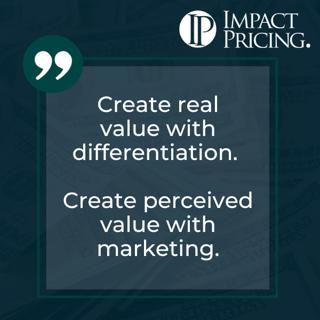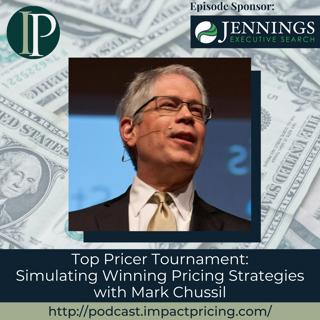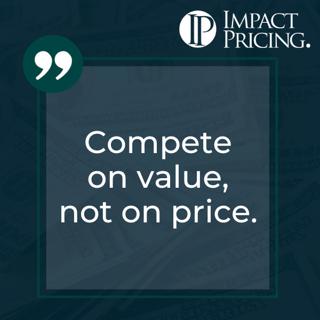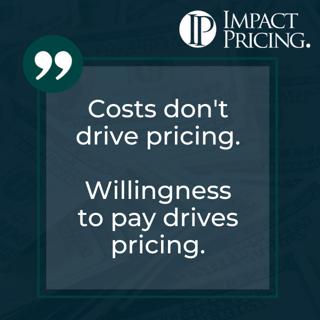
Pricing Table Topics: Queen of Diamonds – Create Perceived Value with Marketing
This one is the Queen of Diamonds from the Impact Pricing card deck. We often talk about how we want products that are different from our competitors. And if we think about what we want to build, we want to build products that are better, that are somehow differentiated. And when we do that, we've truly built value for our customers because our products are better than our competitor's products. However, sometimes our customers don't know that our products are better. And if they don't know our products are better and they've never used our product before, then we're not going to get paid more because our products are better. And so, that's a customer's perception. We need to make sure that our customers perceive our products to be better. In the ideal world, we build products that are better. We communicate that ideal differentiation to our customers. And our customers then choose to buy our product because they've perceived that value. Now, it's possible that we can communicate value that may not be true, or we could communicate value that may not be differentiated. One of my favorite papers I read when I was a doctoral student was titled something like, Meaningful Differentiation from Irrelevant Attributes. The example they like to use was Folgers Mountain Grown Coffee. I mean, it turns out all coffee is grown in mountains, so Folgers isn't differentiated with that. But the fact that they tout it, the fact that they talk about it and communicate it, almost makes it feel like they're differentiated. So, you could think of that as perceived value, even if it isn't real value. So, our job really should be, let's create products that are better than our competitors and let's communicate that to our customers. We hope you enjoyed this example of Pricing Table Topics. What you just heard was done without a script. If you want to get better at speaking about pricing and value, grab a deck of our playing cards, pick a card, read the saying, then talk for one to two minutes about what that card says. You'll become a better speaker and expert. And, you can play card games. If you have any questions or feedback, please email me, mark@impactpricing.com. Now, go make an impact. Connect with Mark Stiving: Email: mark@impactpricing.com LinkedIn: https://www.linkedin.com/in/stiving/
22 Marras 20232min

Top Pricer Tournament: Simulating Winning Pricing Strategies with Mark Chussil
Mark Chussil is the founder of Advanced Competitive Strategies, Inc. He is an expert in qualitative and quantitative business war games, custom strategy simulators, executive education and management development programs. Highly rated speaker, published books and dozens of articles on business and competitive strategy. In this episode, Mark shares how simulating pricing strategies before actually implementing them can do away with costly outcomes thereby improving one's bottom line. Why you have to check out today's podcast: Discover the essence of the Top Pricer Tournament Enhance your pricing strategy by utilizing simulation techniques to mitigate potential risks and minimize losses Find out fascinating insights and findings from the 'Top Pricer Tournament' and learn what to expect when participating in this exciting event "If we choose a good strategy that turns out to be bad, what we have actually encountered is a false positive. And what we need to do a whole lot better in business is to be able to distinguish the false positives from the true positives. And that's what these simulations are about." - Mark Chussil Topics Covered: 02:59 - Differentiating decision rules versus decisions 05:31 - Mark Chussil agreeing to what Mark Stiving says in reference to Axelrod's 'tit for tat' and 'tit for tat with forgiveness' 07:16 - Drawing inspiration from Axelrod's work, Mark describes his own contribution 09:51 - Mark Chussil's perspective on Mark Stiving's assertion that companies prioritizing profit outperform those aiming for market share 11:15 - Findings about 'tit for tat' on why it doesn't work 12:17 - What is 'Top Pricer Tournament' and how it relates to or differ from 'Prisoner's Dilemma' 16:07 - Surprising findings from his own 'Top Pricer Tournament' 21:37 - Things to expect when you join Top Pricer Tournament 24:58 - Mark's best pricing advice 27:12 - Relating strategy to a decision Key Takeaways: "Strategy is a bet." - Mark Chussil "In the Top Pricer Tournaments, and in life in general, we have situations where we can make great decisions, but somebody else has made a better decision or somebody else has come up with something that we didn't think about." - Mark Chussil "I have seen people come up with strategies that I know I never would have thought of. And there's also a few that are in the Top Pricer Tournament that no human has selected yet, and that would outperform any of the ones that humans have selected so far." - Mark Chussil People /Resources Mentioned: The Evolution of Cooperation by Robert Axelrod: https://www.amazon.com/Evolution-Cooperation-Revised-Robert-Axelrod/dp/0465005640 Connect with Mark Chussil: LinkedIn: https://www.linkedin.com/in/markchussil/ Email: mchussil@competing.com Connect with Mark Stiving: LinkedIn: https://www.linkedin.com/in/stiving/ Email: mark@impactpricing.com
20 Marras 202330min

Blogcast: Rules of Thumb for Price Increases
This is an Impact Pricing Blog published on October 5, 2023, turned into an audio podcast so you can listen on the go. Read Full Article Here: https://impactpricing.com/blog/rules-of-thumb-for-price-increases/ If you have any feedback, definitely send it. You can reach us at mark@impactpricing.com. Now, go make an impact. Connect with Mark Stiving: Email: mark@impactpricing.com LinkedIn: https://www.linkedin.com/in/stiving/
17 Marras 20233min

Pricing Table Topics: Queen of Hearts – Value-based Pricing
This one is the Queen of Hearts from the Impact Pricing card deck. Value-based pricing has many different meanings. Different people use it differently. Oftentimes, it's used to say, what's the value of each individual feature that's different between your product and your competitors, and add that to your competitors price. And by the way, that's a great way to think about value and value-based pricing. But the easiest definition I've heard of for value-based pricing is, charge what your customers are willing to pay. And I love this definition because sure, it takes into account the fact that we sometimes have competitors. And we want to know what's the value of our differentiation relative to our competitors' products. Absolutely, these are crucial things for us to know. But we also get to discover, what happens if they're not considering competition at the time? Or, what happens if it's raining and we want to sell an umbrella? So, these differences in time, differences in use cases, these things all have impact in how our customers value our products. And likewise, how much they would be willing to pay for our solutions to their problems. So, I love this concept or this idea that says, look, we all want to charge based on how much value our customers are getting. That would be value-based pricing. But the way to think about it is, how much is a customer willing to pay because that's how much they value your product. We hope you enjoyed this example of Pricing Table Topics. What you just heard was done without a script. If you want to get better at speaking about pricing and value, grab a deck of our playing cards, pick a card, read the saying, then talk for one to two minutes about what that card says. You'll become a better speaker and expert. By the way, you can also play card games. If you have any questions or feedback, please email me, mark@impactpricing.com. Now, go make an impact. Connect with Mark Stiving: Email: mark@impactpricing.com LinkedIn: https://www.linkedin.com/in/stiving/
15 Marras 20232min

Quantifying Value: The Key to Selling with Confidence with John Mansour
John Mansour founded Product Management University to unlock one's full growth potential by making quantifiable customer outcomes the starting point for everything. In this episode, John explains the concept of buyers trading money for value. Therefore, it is crucial to consider the quantifiable value aspect, as it forms the basis for developing effective pricing strategies. Why you have to check out today's podcast: Understand why it is crucial to prioritize providing value to customers when a company's sustainability is on the line Learn the difference in measuring quantitative value in B2C and B2B contexts in order to effectively deliver the value and achieve the desired outcomes for your customers, and price your offer accordingly Discover how to identify the most straightforward quantifiable value component and use it as a foundation to develop the optimal pricing strategy "The quantifiable value piece is so important in what we do, which is, if you can quantify a unit of value to the customer for what your products are doing, that is a good starting point to figure out your pricing." - John Mansour Topics Covered: 01:31 - Reading a snippet from John's LinkedIn About Section 02:04 - What prompted him to conceive that idea in his LinkedIn About section? 04:56 - Why often customer value comes only secondary to most companies 06:49 - A matter of a discovery journey and digging down the customer's why 09:28 - One key thing to understand when dealing with your customers' key decision makers for your questions to be relevant to them 11:17 - Quantifying value in B2C versus B2B 12:52 - Ways to measure quantitative value 15:03 - Measuring quantitative value other than in dollars 19:26 - A process for identifying quantifiable value [case studies illustrating this] 22:43 - John's best pricing advice Key Takeaways: "If you deliver quantifiable value to the customer, it's going to come back to you in spades to your own organization and support whatever your strategic goals are." - John Mansour "It's a matter of just understanding what their priorities and their agenda is. Because if they're going to trade value for money, we have to understand what's valuable to them and how it can be quantified." - John Mansour "The dollars aren't always at the forefront. It's the impact that you have on things that are important." - John Mansour "The more you can quantify those units of value, the easier it is to come up with a price that you can sell because you're selling the value." - John Mansour Connect with John Mansour: LinkedIn: https://www.linkedin.com/in/johnmansourproductmanagementuniversity/ Connect with Mark Stiving: LinkedIn: https://www.linkedin.com/in/stiving/ Email: mark@impactpricing.com
13 Marras 202325min

Pricing Table Topics: Queen of Spades – Compete on Value, Not on Price
This one is the Queen of Spades from the Impact Pricing card deck. We really should be competing on value, not on price. We often think we're in a price war with our competition. We think our competitors are competing on price because we watch them give deep discounts to customers when we're in negotiations and we're wondering, why are they competing on price? But if you think about it, we responded with deep discounts on our products, and they look at us and they say, why are they competing on price? What we really need to do is hold our price, try to maintain that price at a nice high level, and instead explain why our product is worth so much more money than our competitors. If our competitors are going to lower their price, it's probably because their product isn't as valuable as our product. We need to learn what does value truly mean to our customers and help them understand how much value they're going to get. When we learn to create, communicate, value better, we'll be able to capture more of it in the way we price and the deals we close. We hope you enjoyed this example of Pricing Table Topics. What you just heard was done without a script. If you want to get better at speaking about pricing and value, grab a deck of our playing cards, pick a card, read the saying, and talk for one to two minutes about what that card says. You'll become a better speaker and expert. By the way, you can also play card games. If you have any questions or feedback, please email me, mark@impactpricing.com. Now, go make an impact. Connect with Mark Stiving: Email: mark@impactpricing.com LinkedIn: https://www.linkedin.com/in/stiving/
10 Marras 20232min

Pricing Table Topics: King of Clubs – Willingness to Pay Drives Pricing
This one is the King of Clubs from the Impact Pricing card deck. Sadly, too many companies still use cost-plus pricing. We take the cost of manufacturing or creating something, we add a margin, and there's our price. It's easy. We know we're making margin, but are we maximizing our profit? Maybe we're pricing so high that we miss out on some customers, or maybe we're pricing so low that we're missing out on what some customers would be willing to pay us. Think about it this way. Imagine that it costs you $10 to build something, all in. Whatever costs you want to consider, great. And you have a buyer out there that's willing to pay you $100 for it. What's the profit-maximizing price that you could charge? Well, it's a hundred dollars. If you charge 99, you left a dollar on the table. If you charge a hundred and one, that buyer's not going to buy. And so, a hundred dollars is the best you could possibly do with that buyer. But what if instead of costing you ten dollars, what if it cost you twenty-five dollars to make it? Same buyer. What price would be the profit maximizing price? Well, obviously it's still a hundred dollars. Mind you, we make less money because our costs are higher. But the best we can do price-wise is the $100 because that's what our customer is willing to pay. When we think about pricing this way, we're not saying costs don't matter to business. What we are saying is costs don't really matter to us setting our price. Yes, we want to make sure our prices are above our costs. We want to make sure we're making money. So, think of it as a limit. But it isn't the thing that drives our price levels. We hope you enjoyed this example of Pricing Table Topics. What you just heard was done without a script. If you want to get better at speaking about pricing and value, grab a deck of our cards, pick a card, read the saying, and then talk for one to two minutes about what that card says. You'll become a better speaker and expert. If you have any questions or feedback, please email me, mark@impactpricing.com. Now, go make an impact. Connect with Mark Stiving: Email: mark@impactpricing.com LinkedIn: https://www.linkedin.com/in/stiving/
8 Marras 20232min

Maximize Profits with Intelligent Pricing through Customer Segmentation with Nikhil Kalla
Nikhil Kalla is a Global Pricing Manager at Ingersoll Rand who collaborates closely with regional pricing and global cross functional teams to drive projects that build pricing governance, create value propositions, align pricing with the market by applying segmentation, harmonization, rationalization and market research. In this episode, Nikhil shares the significance of customer segmentation in developing a product that caters to different pricing tiers - top, middle, and low. This approach ensures that the product aligns with customers' willingness to pay based on the value they receive. "If we had known our customer more or the most, you would have been able to segment your market and gain maximum on your profitability." - Nikhil Kalla Why you have to check out today's podcast: Learn how customer segmentation drives different pricing points while still attracting customers from various segments Gain insights into the significance of customer segmentation in shaping product design and establishing pricing strategies that cater to customers' varying levels of willingness to pay Find out how proper communication of your product's value can help you gain the most advantage in pricing Topics Covered: 01:46 - What's all this obsession of Nikhil over mastering Rubik's cube 02:52 - How he found himself in pricing 04:31 - Defining customer segmentation 07:09 - Customer segmentation by way of price segmentation 08:59 - What goes into approving different price points for different customers and even for the same ones 11:20 - What drives different pricing mix 17:18 - Market segmentation as a way to sell your products more intelligently 19:40 - How this works: Two different products targets two different market segments with two different price points 26:42 - Explaining what real-life scenario versus assumptions when talking about value to price ratio[how packaging works as part of customer segmentation] 30:23 - Nikhil's best pricing advice Key Takeaways: "Customer segmentation is all about deriving value, the maximum value from your customer base." - Nikhil Kalla "Other than just being value and pricing, I feel there's more about communication of that value and then convincing part to be able to fetch maximum price so that the ratio of value by price is least as a win for me if I'm the supplier. And it has to be maximum so that the buyer gets to gain the most out of that transaction." - Nikhil Kalla "When it comes to having the ability to sell to a slightly non elastic market where the demand is going to be expected to stay the same, you would always want to rely on pricing as a lever. Because everything that comes through pricing just goes to your pocket." - Nikhil Kalla Connect with Nikhil Kalla: LinkedIn: https://www.linkedin.com/in/nikhil-kalla Connect with Mark Stiving: LinkedIn: https://www.linkedin.com/in/stiving/ Email: mark@impactpricing.com
6 Marras 202333min






















